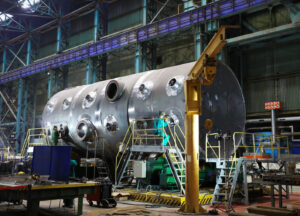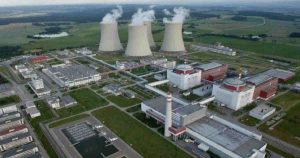Within the physical start-up programme of the innovative Power unit No. 6 (Power unit No. 1 of the NovovoronezhNPP-2), the Novovoronezh NPP started loading fuel into the VVER-1200 reactor core recently and on March 25,2016 reached its active phase.
The Power unit No. 1 of the Novovoronezh NPP-2 is the first in the world generation 3+ unit to go for physical start-up . It is a standard generation 3+ design of a Russian NPP with improved performance indicators and assembled as per NPP-2006 design with VVER-1200 reactor. It has been designed by Atomenergoproject of Russia
Today, power units with VVER-1200 reactors at various stages of their implementation are at the sites of Leningrad NPP-2 and Novovoronezh NPP-2 as well as NPPs in Belorussia, Turkey, Egypt, Finland, Hungary and Bangladesh.
Latest evolutionary modification in the range of VVER designs- AES -2006 complies with the safety requirements, environmental and sanitary laws and regulations as well as IAEA and EUR requirements.
The design safety functions are ensured by independent operation of passive and active systems which guarantees its accident-free operation and both environmental stability and resistance to internal actions. The design has passed over 20 IAEA special missions to be declared one of the safest units by IAEA experts.
The major feature of the design is the use of extra passive safety systems along with traditional active systems with the former systems operating due to natural processes which significantly decreases impact of the human factor on safety. The new design ensures protection from earthquakes, tsunamis, hurricanes and aircraft crash. Examples of the innovations used in this design are as follows
“Start-up and subsequent operation of Power unit No. 1 of the Novovoronezh NPP-2 of new generation 3+ ,which is the most powerful one in this country will give Russia additional advantages at the international market of NPP construction,” says Sergey Kondratyev, Head of Economic Department of Energy and Finances Institute Fund.
Improved confining safety systems include double confinement of the reactor hall and an LFCM trap installed under the pressure vessel which ensures no activity release to the environment and acts as physical protection against natural disasters, technological accidents and other emergencies ; 2 active and fully independent safety channels with internal redundancy of active elements; Passive residual heat removal system to ensure continuous residual heat removal in case if there are no power-supply sources available;
The design features extra safety measures developed with due consideration of stress tests implemented at NVNPP-2 in 2012 with the conditions more extreme than those at the NPP Fukushima imitated during the stress tests. For instance, such unlikely scenarios as primary circuit leak with loss of all power-supply sources and all ultimate heat sinks for over 24 hours were postulated. Following the test results, such extra safety elements as an air-cooled mobile diesel generator and special circuit with an air cooling tower and a diesel-driven pump were introduced into the design. In general, the equipment and technologies used during construction of Novovoronezh NPP-2 are unique and innovative in many ways.
The design has been implemented with the use of the most powerful to date VVER-type reactor. A high-speed turbine has been developed for the design specifically for the new generation of power units. These solutions are designed to improve the efficiency and reliability of nuclear power plants. In particular, fill capacity factor has been increased, operation period of main equipment of the reactor unit has been increased up to 60 years and design service life of structural unit has been increased up to 100 years.
Reactor start-up stage has been implemented at the moment which includes nuclear fuel loading into nuclear reactor core (fuel assembly loading), operation with rated power and implementation of the tests necessary to confirm design parameters for fuel loading. Once this stage has been finished the power unit will be ready for the first start stage that comprises connection of the unit to power grid and beginning of its industrial operation. – Triune Group press release




